The AMD Llano Notebook Review: Competing in the Mobile Market
by Jarred Walton & Anand Lal Shimpi on June 14, 2011 12:01 AM ESTFusion GPU Takes on Gaming
For our gaming tests, we’ll start with our Low and Medium detail gaming benchmarks. We’ll save Asymmetrical CrossFire and High detail gaming for the next page. Note that we run all of the Low and Medium tests using DX9/DX10 modes, even on games that support DX11. There reason is simple: in nearly every game with DX11 support, enabling it often proves too taxing for anything but the fastest discrete GPUs—or in other cases, the graphics quality difference is negligible (Civilization V, Metro 2033, and Total War: Shogun 2 fall into this category). When we refresh our list of games later this year, we might start testing DX11 more often, but for now we’ll stick with DX9/10 on mainstream laptop testing.
Low Detail Gaming
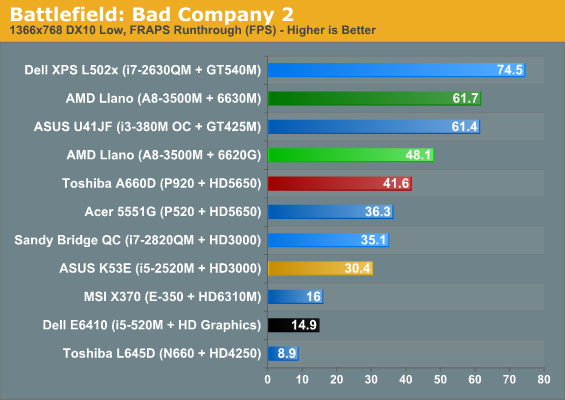
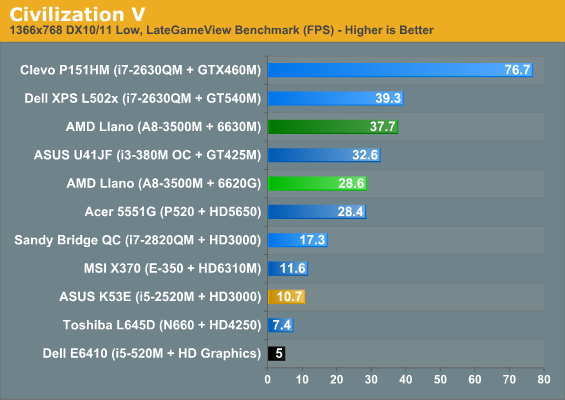

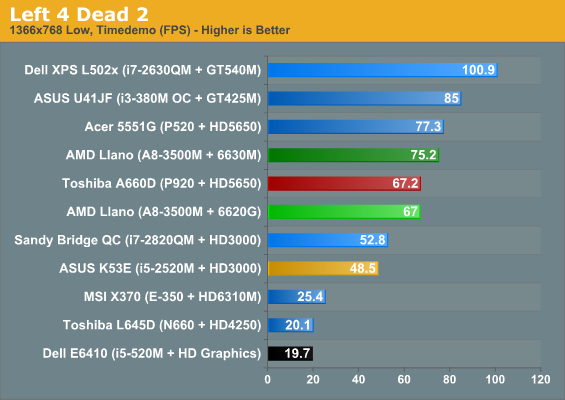
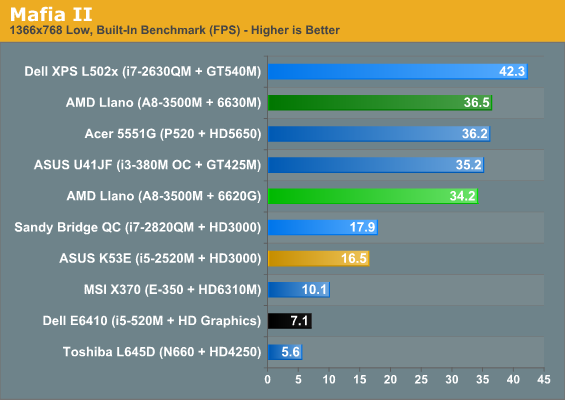

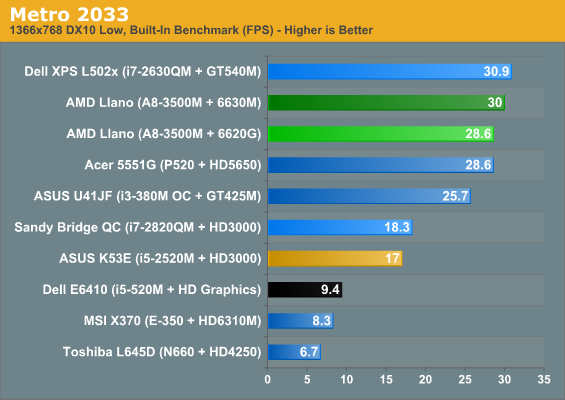
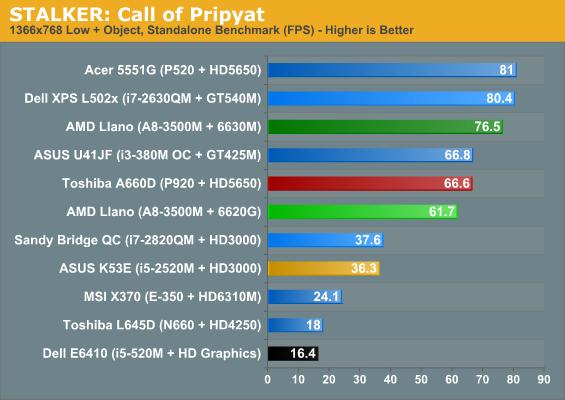
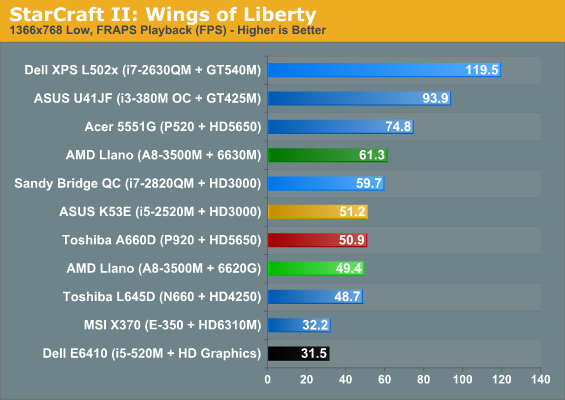
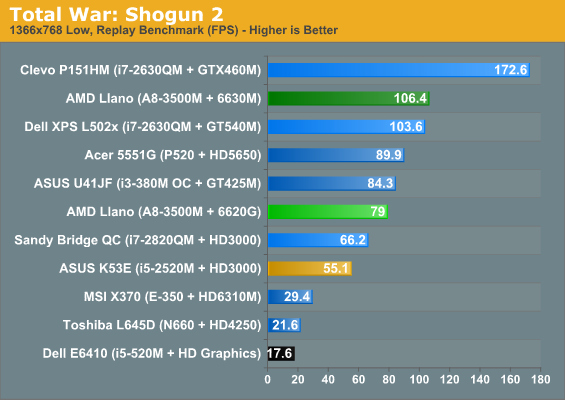
Medium Detail Gaming
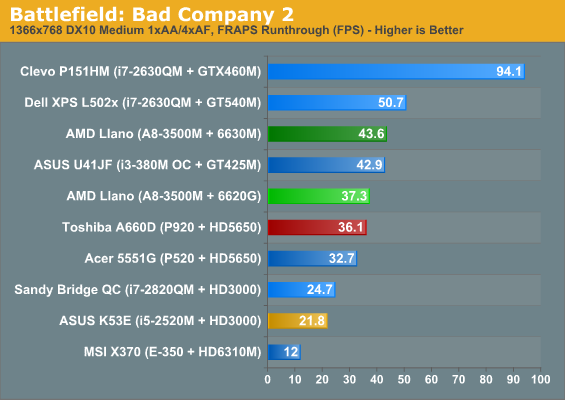
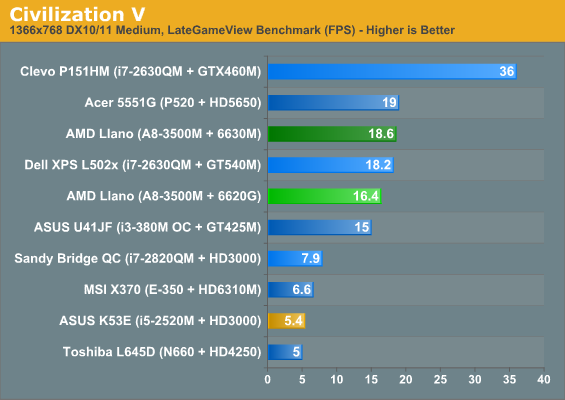
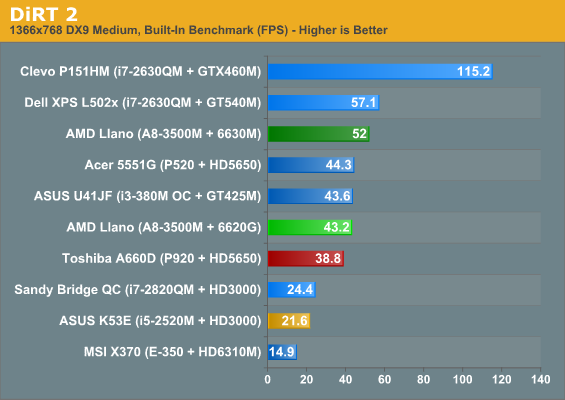
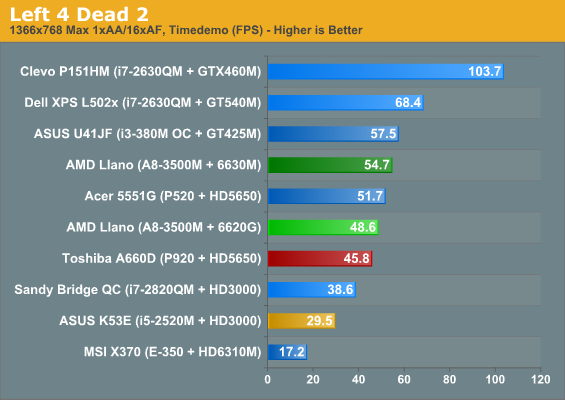

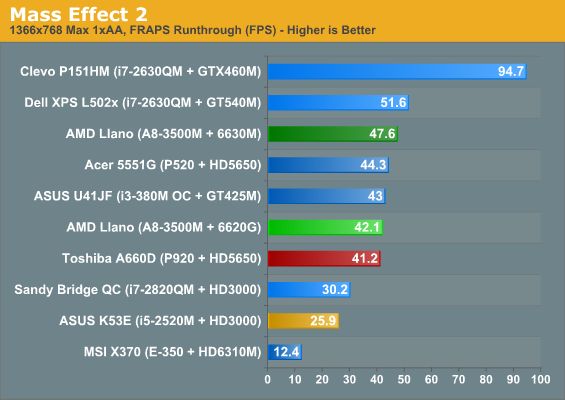
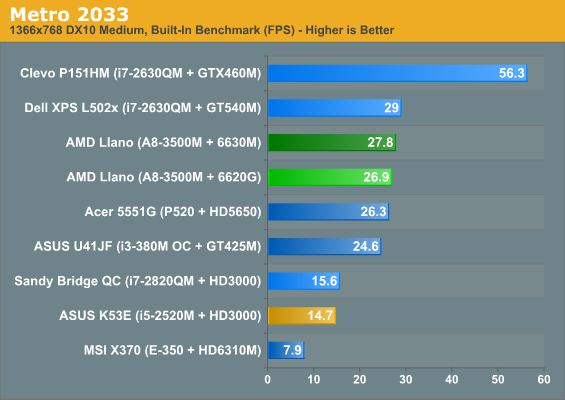
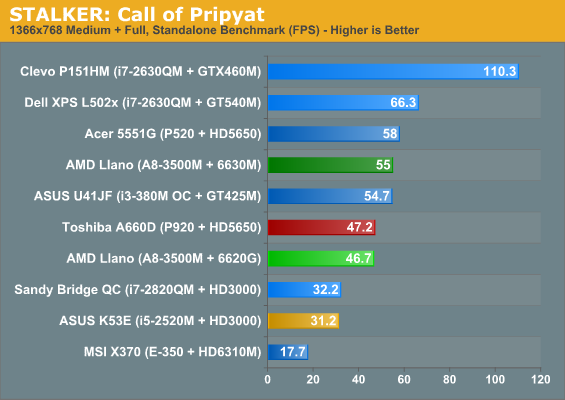
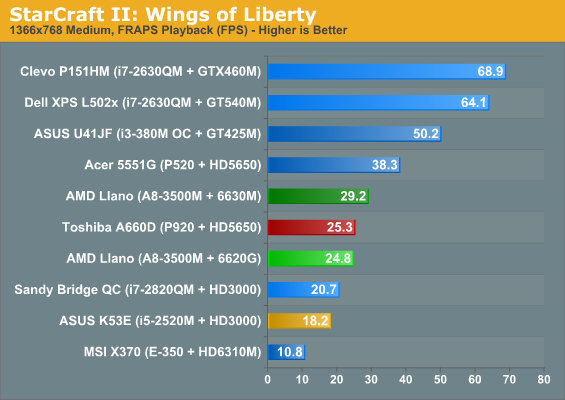
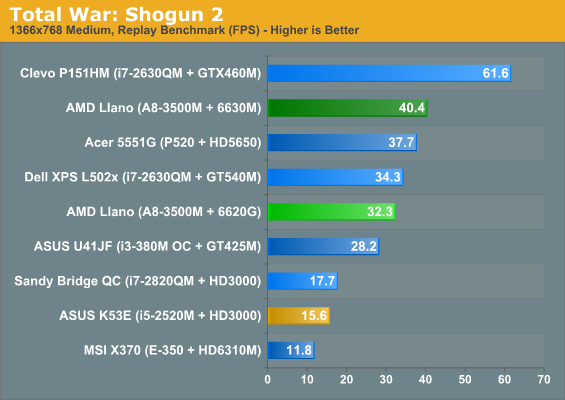
The age-old adage is that if you want a good gaming experience, you need to put more money into the graphics subsystem. With Llano, we need to modify that and add a corollary that you can trade a faster CPU for a better IGP/fGPU and end up with acceptable gaming performance. The 6620G is the first integrated GPU that can actually keep pace with the midrange discrete GPUs (at least on laptops—desktop GPUs are a different story). The Llano A8-3500M comes out ahead of AMD’s previous P920 + HD 5650 in many of the results, while A8-3500M + HD 6630M adds anywhere from 3-40% and averages 24% faster than the 6620G.
If we look at the competition, A8-3500M is anywhere from -3.5% to 167% faster than Intel’s HD 3000 with dual-core SNB, running everything at our Low presets. The sole victory for Intel comes in the lightly-threaded StarCraft II where Intel can really flex its Turbo Boost muscles. On the other end of the spectrum, HD 3000 turns in extremely poor results in Civilization V, Mafia II, and Metro 2033—games where Llano is at least playable. On average, the A8-3500M is 50% faster than HD 3000 at Low settings; move up to our Medium settings and Llano is 76% faster on average, with leads in every title ranging from 36% (StarCraft II is again the worst showing for AMD) to as much as 204% (Civilization V).
Bring the older Arrandale into the picture and things get even more lopsided. Never mind the fact that Arrandale’s HD Graphics are unable to break 30FPS in most of our test games at minimum detail (StarCraft II being the one exception); at our Low presets, A8-3500M puts Arrandale to shame, with performance anywhere from 57 to 472 percent faster and 223% faster on average. Obviously, you don’t want to try gaming on Arrandale’s IGP, which is where laptops like the ASUS U41JF come into play. You can pick up the U41JF for just over $800, but while the CPU is certainly faster, gaming performance with the GT 425M is only 15% faster than the stock A8-3500M on average, with Llano pulling wins in Civ5, Metro 2033, and TWS2 at Medium detail.
As a final note on gaming performance, while the A8-3500M isn’t clocked particularly high, there’s still more performance on tap in many games. Switching over to the 6630M dGPU improves performance by an average of 20% over the fGPU. A few titles only show an incremental performance increase (Metro 2033 and Mafia II); the biggest performance gains come in DiRT 2 and Total War: Shogun 2, with performance increases of 40%/35% respectively at low detail and 20%/25% at medium detail.
The target price of $700 for A8 laptops could make for a reasonably powerful and inexpensive gaming laptop, and if it’s like current AMD notebooks I suspect we’ll see A8 laptop prices dip into the low $600s. $800 for A8 Llano with the 6630M becomes a more difficult proposition, considering it would butt up squarely against laptops like the U41JF. Gaming performance would be similar, but the larger battery would give ASUS (and Intel) the lead in that area and gaming performance would be largely a wash. Depending on how much of a threat Intel deems Llano to be, we could see SNB laptops similar to the U41JF push pricing down, but for now Llano certainly fills a popular market niche.










177 Comments
View All Comments
DanNeely - Tuesday, June 14, 2011 - link
Just looking at transistor count misses most of the story. The highly repetitive layout in the GPU allows for much denser transistor layout, the die is only 5% larger. That's close enough that factors like yield and raw per wafer cost become at least as important.Lunyone - Tuesday, June 14, 2011 - link
Looks like we're finally getting close to having integrated graphics good enough for some good light gaming :) Hopefully these won't be priced to high to sell. There are sooo many Sandy Bridge based laptops out there that are within the $500-600 price range it isn't even funny. I hope we can get the top of the line Llano for about $600-650. I think the C50 or E-350 have been relegated down to tablet only now, since Llano is where it's at now.ET - Tuesday, June 14, 2011 - link
Brazos will likely keep its place at the lower price point and smaller size laptops. It would be interesting to see if the larger E-350 laptops will be replaced by Llano or will survive. I was surprised they were even introduced, but it's possible that if people are buying them they will continue to do so.Still, I'm hoping that Llano can make it into small form factor laptops.
Beenthere - Tuesday, June 14, 2011 - link
I am definitely ready to buy a Llano powered laptop. I suspect Llano will suit the needs of the largest notebook segment and deliver better graphics at a lower price point. AMD is bound to take notebook market share from Intel. I wouldn't ever consider an Intel product.RussianSensation - Tuesday, June 14, 2011 - link
What? The largest notebook segment doesn't care about GPUs in a laptop. Look at Apple - a non-gaming platform more or less - and quarter after quarter has the highest growth in the notebook market share. The fact that Intel HD graphics command #1 market share in the mobile and desktop space also shows that the the majority of consumers don't care about mobile graphics beyond watching HD content.So with Llano you get a GPU that's still only fast enough for 1368x768 resolution gaming at the lowest settings and CPU performance that's only as fast as a Q6700 from 2007. Llano only makes sense if you are on a budget to buy a laptop. If you care about CPU performance, it's too slow. If you care about GPU performance, it's again too slow. So the only customer it will find is a niche one until they can create an APU with Bulldozer cores inside and a much faster GPU.
We have also seen a significant surge in consumers that desire premium made notebooks. Llano designs will likely be relegated to cheap looking and cheap quality laptops. Certainly it wont be able to compete with Ultrabooks.
I am almost certain that most of today's consumers will care about screen resolution, an SSD, the quality of the screen/materials build quality of the laptop before even thinking about the fact that Llano's GPU is faster than Intel's. Then there is AMD's past history of having unimpressive mobile CPUs over the last 5+ years. It's going to take 2-3 generations before consumers even think about switching brands in such a scenario. Most people will just buy an Intel based SB notebook simply because Intel has made the best mobile processor for the last "forever".
This is a good step for AMD, but they have a long road ahead.
duploxxx - Tuesday, June 14, 2011 - link
The share count is no longer relevant since an IGP is deployed anyhow with each system, while there are many delivered with discrete it still counts as an IGP also.Have a look at your so called apple highest growth market... it ships with discrete ATI graphics.....
Actually most don't know that the IGP is crappy, they are fooled by adiot sales and large electronic vendors who try to push there margins.
THis is the introduction generation that will shed some light, just look at the brazos also, it has been a success and even atom refresh wil not be able to take this back.
nickb64 - Tuesday, June 14, 2011 - link
arguably the most popular Apple laptop, the 13" Pro, now ships with Intel Integrated graphics, not discrete ATI/AMD graphicsOverall, you're right, but I just wanted to point out that Intel is probably getting a pretty solid boost out of 13" MBP sales this year.
jjj - Tuesday, June 14, 2011 - link
lol that's quite something to give Apple as an example for what the average user needs.Macs are niche products and will remain so without fundamental strategy changes.ps:how outraged would you be if tomorrow the new Air shows up with a Llano in it?
pps:today's average consumer makes a few hundreds $ per month and is not looking for high resolution (not that he knows wtf resolution is anyway) or SSD.
RussianSensation - Tuesday, June 14, 2011 - link
Intel wouldn't ship Air with Llano, not until they can deliver Bulldozer cores. Why would they ship a laptop with 50% slower CPU speed and go backwards? Not to mention, they'd lose Thunderbolt if they ditched SB.mino - Tuesday, June 14, 2011 - link
Thunderbolt is PCIe.